Report on Communication Skills and Business Strategies for Success
VerifiedAdded on 2020/10/04
|11
|2808
|400
Report
AI Summary
This report provides a comprehensive overview of communication skills essential for business success. It begins by defining communication and exploring various models such as Aristotle's persuasion model, New-comb's inter-personal communication model, and Thayer's organizational communication model. The report then examines different communication systems, including optical and duplex systems, and methods such as written, verbal, non-verbal, and electronic communication, highlighting the benefits of formal and informal communication. The principles of effective communication, including clarity, objectivity, completeness, and timeliness, are discussed, along with common barriers like semantic, psychological, and personal behavior barriers. The report further delves into oral communication through a simulated customer service interview and examines written communication through examples of a CV, email, and a formal letter, demonstrating practical application of these skills. The assignment emphasizes the significance of effective communication in fostering successful business operations.
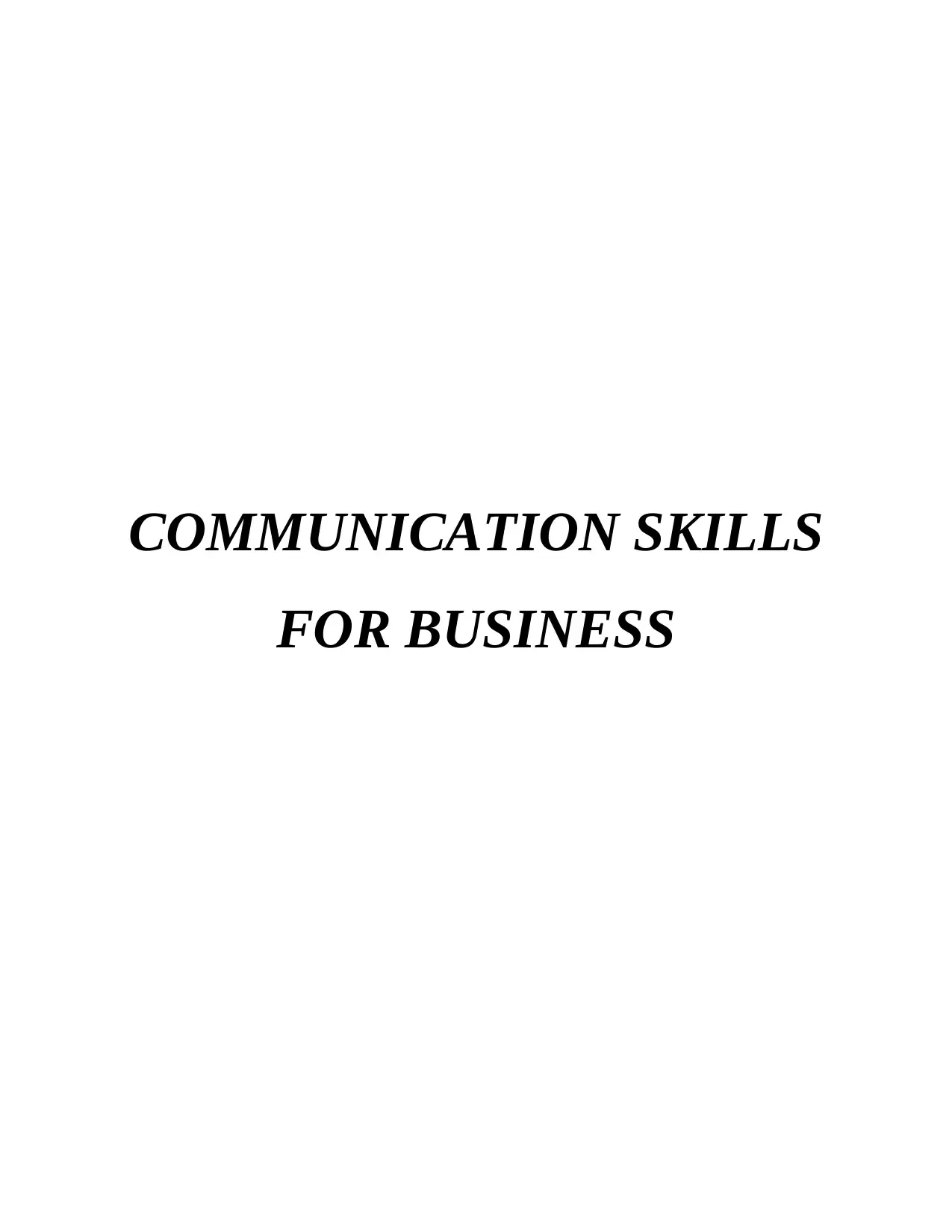
COMMUNICATION SKILLS
FOR BUSINESS
FOR BUSINESS
Paraphrase This Document
Need a fresh take? Get an instant paraphrase of this document with our AI Paraphraser
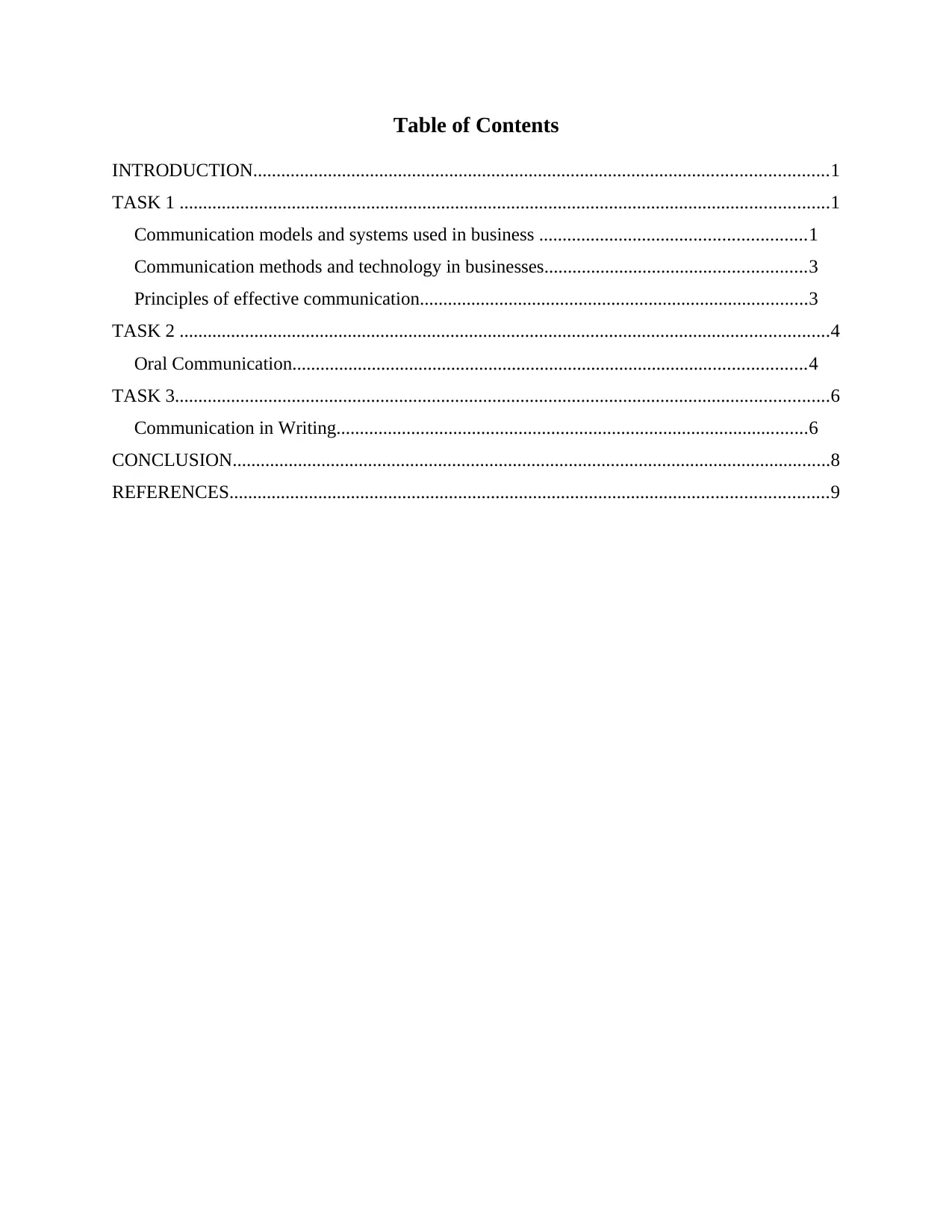
Table of Contents
INTRODUCTION...........................................................................................................................1
TASK 1 ...........................................................................................................................................1
Communication models and systems used in business .........................................................1
Communication methods and technology in businesses........................................................3
Principles of effective communication...................................................................................3
TASK 2 ...........................................................................................................................................4
Oral Communication..............................................................................................................4
TASK 3............................................................................................................................................6
Communication in Writing.....................................................................................................6
CONCLUSION................................................................................................................................8
REFERENCES................................................................................................................................9
INTRODUCTION...........................................................................................................................1
TASK 1 ...........................................................................................................................................1
Communication models and systems used in business .........................................................1
Communication methods and technology in businesses........................................................3
Principles of effective communication...................................................................................3
TASK 2 ...........................................................................................................................................4
Oral Communication..............................................................................................................4
TASK 3............................................................................................................................................6
Communication in Writing.....................................................................................................6
CONCLUSION................................................................................................................................8
REFERENCES................................................................................................................................9
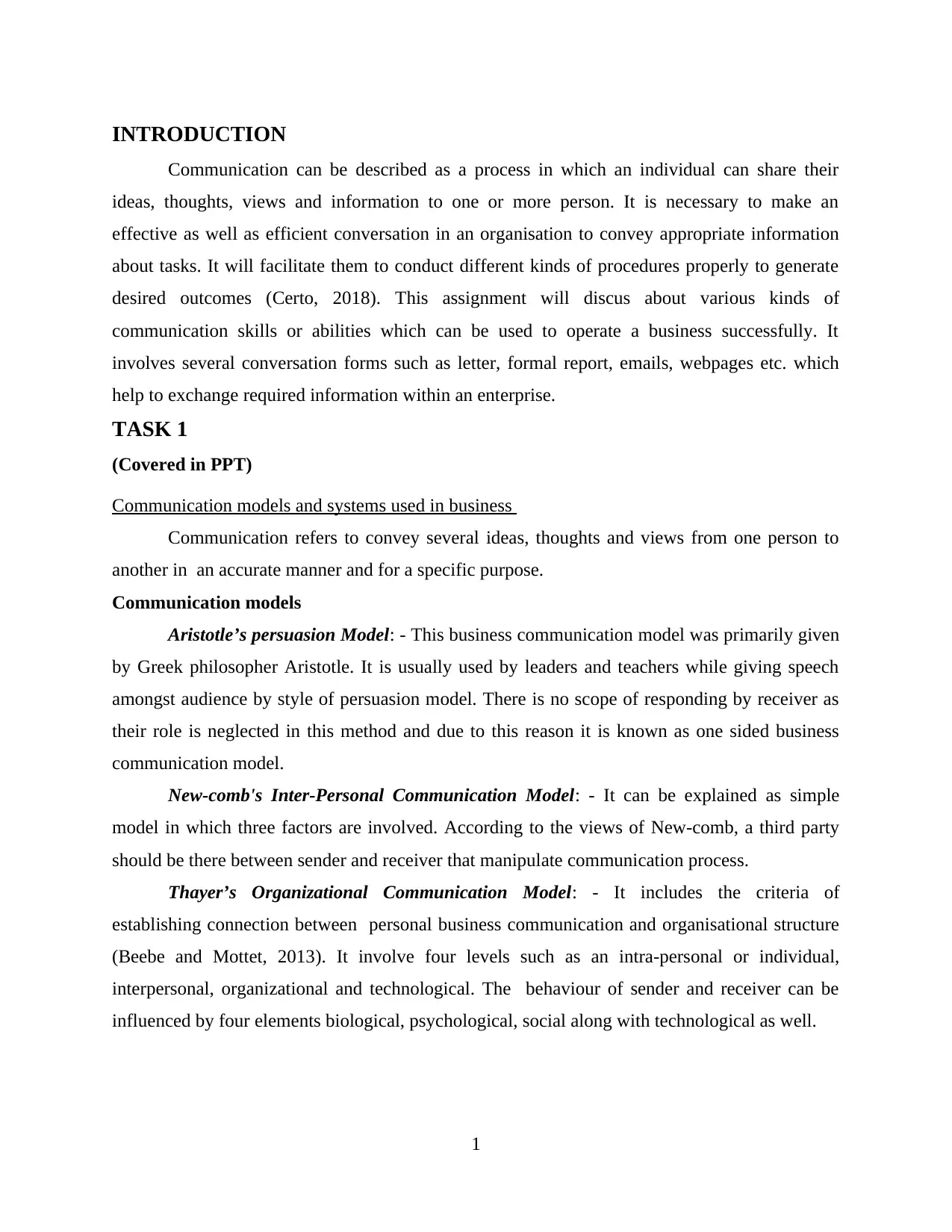
INTRODUCTION
Communication can be described as a process in which an individual can share their
ideas, thoughts, views and information to one or more person. It is necessary to make an
effective as well as efficient conversation in an organisation to convey appropriate information
about tasks. It will facilitate them to conduct different kinds of procedures properly to generate
desired outcomes (Certo, 2018). This assignment will discus about various kinds of
communication skills or abilities which can be used to operate a business successfully. It
involves several conversation forms such as letter, formal report, emails, webpages etc. which
help to exchange required information within an enterprise.
TASK 1
(Covered in PPT)
Communication models and systems used in business
Communication refers to convey several ideas, thoughts and views from one person to
another in an accurate manner and for a specific purpose.
Communication models
Aristotle’s persuasion Model: - This business communication model was primarily given
by Greek philosopher Aristotle. It is usually used by leaders and teachers while giving speech
amongst audience by style of persuasion model. There is no scope of responding by receiver as
their role is neglected in this method and due to this reason it is known as one sided business
communication model.
New-comb's Inter-Personal Communication Model: - It can be explained as simple
model in which three factors are involved. According to the views of New-comb, a third party
should be there between sender and receiver that manipulate communication process.
Thayer’s Organizational Communication Model: - It includes the criteria of
establishing connection between personal business communication and organisational structure
(Beebe and Mottet, 2013). It involve four levels such as an intra-personal or individual,
interpersonal, organizational and technological. The behaviour of sender and receiver can be
influenced by four elements biological, psychological, social along with technological as well.
1
Communication can be described as a process in which an individual can share their
ideas, thoughts, views and information to one or more person. It is necessary to make an
effective as well as efficient conversation in an organisation to convey appropriate information
about tasks. It will facilitate them to conduct different kinds of procedures properly to generate
desired outcomes (Certo, 2018). This assignment will discus about various kinds of
communication skills or abilities which can be used to operate a business successfully. It
involves several conversation forms such as letter, formal report, emails, webpages etc. which
help to exchange required information within an enterprise.
TASK 1
(Covered in PPT)
Communication models and systems used in business
Communication refers to convey several ideas, thoughts and views from one person to
another in an accurate manner and for a specific purpose.
Communication models
Aristotle’s persuasion Model: - This business communication model was primarily given
by Greek philosopher Aristotle. It is usually used by leaders and teachers while giving speech
amongst audience by style of persuasion model. There is no scope of responding by receiver as
their role is neglected in this method and due to this reason it is known as one sided business
communication model.
New-comb's Inter-Personal Communication Model: - It can be explained as simple
model in which three factors are involved. According to the views of New-comb, a third party
should be there between sender and receiver that manipulate communication process.
Thayer’s Organizational Communication Model: - It includes the criteria of
establishing connection between personal business communication and organisational structure
(Beebe and Mottet, 2013). It involve four levels such as an intra-personal or individual,
interpersonal, organizational and technological. The behaviour of sender and receiver can be
influenced by four elements biological, psychological, social along with technological as well.
1
⊘ This is a preview!⊘
Do you want full access?
Subscribe today to unlock all pages.

Trusted by 1+ million students worldwide
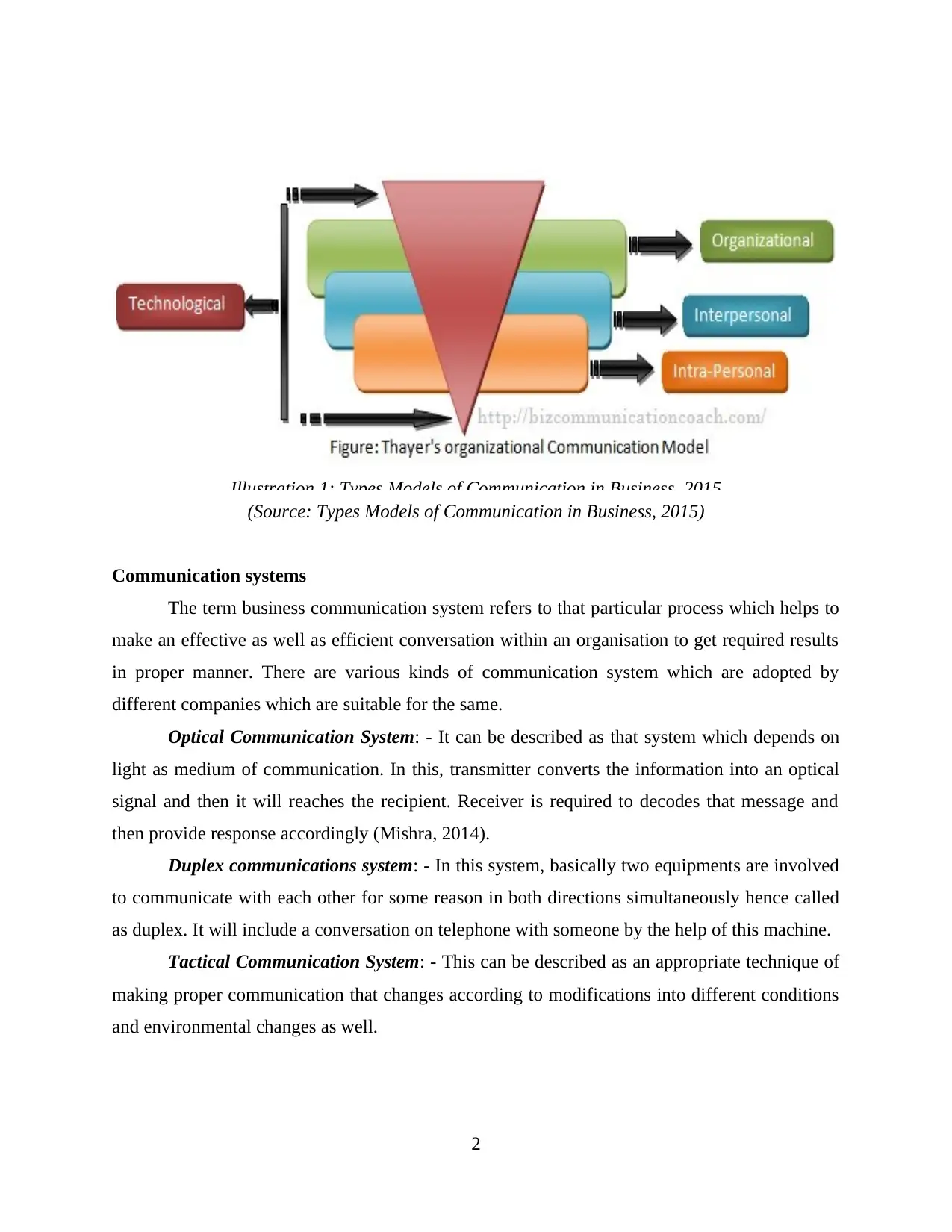
(Source: Types Models of Communication in Business, 2015)
Communication systems
The term business communication system refers to that particular process which helps to
make an effective as well as efficient conversation within an organisation to get required results
in proper manner. There are various kinds of communication system which are adopted by
different companies which are suitable for the same.
Optical Communication System: - It can be described as that system which depends on
light as medium of communication. In this, transmitter converts the information into an optical
signal and then it will reaches the recipient. Receiver is required to decodes that message and
then provide response accordingly (Mishra, 2014).
Duplex communications system: - In this system, basically two equipments are involved
to communicate with each other for some reason in both directions simultaneously hence called
as duplex. It will include a conversation on telephone with someone by the help of this machine.
Tactical Communication System: - This can be described as an appropriate technique of
making proper communication that changes according to modifications into different conditions
and environmental changes as well.
2
Illustration 1: Types Models of Communication in Business, 2015
Communication systems
The term business communication system refers to that particular process which helps to
make an effective as well as efficient conversation within an organisation to get required results
in proper manner. There are various kinds of communication system which are adopted by
different companies which are suitable for the same.
Optical Communication System: - It can be described as that system which depends on
light as medium of communication. In this, transmitter converts the information into an optical
signal and then it will reaches the recipient. Receiver is required to decodes that message and
then provide response accordingly (Mishra, 2014).
Duplex communications system: - In this system, basically two equipments are involved
to communicate with each other for some reason in both directions simultaneously hence called
as duplex. It will include a conversation on telephone with someone by the help of this machine.
Tactical Communication System: - This can be described as an appropriate technique of
making proper communication that changes according to modifications into different conditions
and environmental changes as well.
2
Illustration 1: Types Models of Communication in Business, 2015
Paraphrase This Document
Need a fresh take? Get an instant paraphrase of this document with our AI Paraphraser
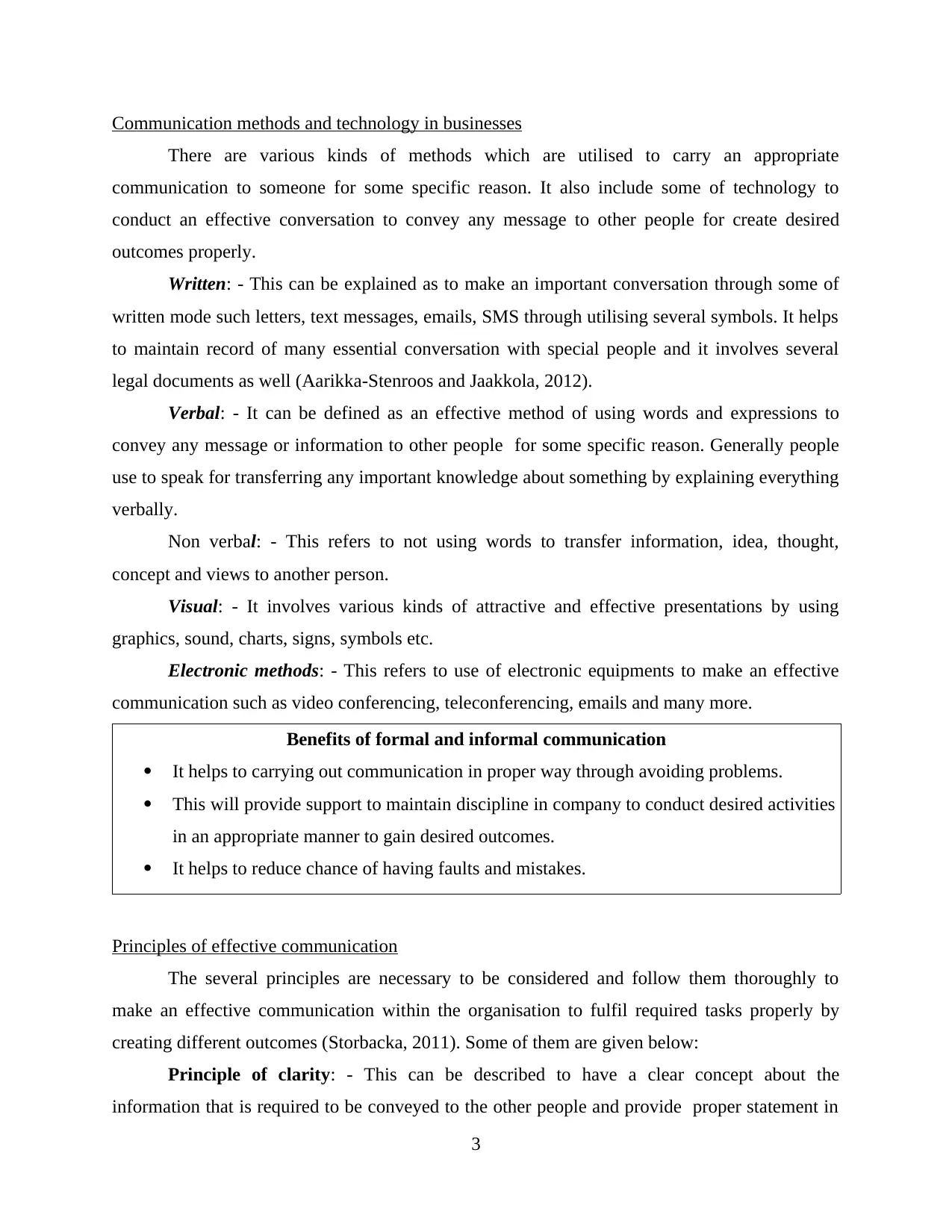
Communication methods and technology in businesses
There are various kinds of methods which are utilised to carry an appropriate
communication to someone for some specific reason. It also include some of technology to
conduct an effective conversation to convey any message to other people for create desired
outcomes properly.
Written: - This can be explained as to make an important conversation through some of
written mode such letters, text messages, emails, SMS through utilising several symbols. It helps
to maintain record of many essential conversation with special people and it involves several
legal documents as well (Aarikka-Stenroos and Jaakkola, 2012).
Verbal: - It can be defined as an effective method of using words and expressions to
convey any message or information to other people for some specific reason. Generally people
use to speak for transferring any important knowledge about something by explaining everything
verbally.
Non verbal: - This refers to not using words to transfer information, idea, thought,
concept and views to another person.
Visual: - It involves various kinds of attractive and effective presentations by using
graphics, sound, charts, signs, symbols etc.
Electronic methods: - This refers to use of electronic equipments to make an effective
communication such as video conferencing, teleconferencing, emails and many more.
Benefits of formal and informal communication
It helps to carrying out communication in proper way through avoiding problems.
This will provide support to maintain discipline in company to conduct desired activities
in an appropriate manner to gain desired outcomes.
It helps to reduce chance of having faults and mistakes.
Principles of effective communication
The several principles are necessary to be considered and follow them thoroughly to
make an effective communication within the organisation to fulfil required tasks properly by
creating different outcomes (Storbacka, 2011). Some of them are given below:
Principle of clarity: - This can be described to have a clear concept about the
information that is required to be conveyed to the other people and provide proper statement in
3
There are various kinds of methods which are utilised to carry an appropriate
communication to someone for some specific reason. It also include some of technology to
conduct an effective conversation to convey any message to other people for create desired
outcomes properly.
Written: - This can be explained as to make an important conversation through some of
written mode such letters, text messages, emails, SMS through utilising several symbols. It helps
to maintain record of many essential conversation with special people and it involves several
legal documents as well (Aarikka-Stenroos and Jaakkola, 2012).
Verbal: - It can be defined as an effective method of using words and expressions to
convey any message or information to other people for some specific reason. Generally people
use to speak for transferring any important knowledge about something by explaining everything
verbally.
Non verbal: - This refers to not using words to transfer information, idea, thought,
concept and views to another person.
Visual: - It involves various kinds of attractive and effective presentations by using
graphics, sound, charts, signs, symbols etc.
Electronic methods: - This refers to use of electronic equipments to make an effective
communication such as video conferencing, teleconferencing, emails and many more.
Benefits of formal and informal communication
It helps to carrying out communication in proper way through avoiding problems.
This will provide support to maintain discipline in company to conduct desired activities
in an appropriate manner to gain desired outcomes.
It helps to reduce chance of having faults and mistakes.
Principles of effective communication
The several principles are necessary to be considered and follow them thoroughly to
make an effective communication within the organisation to fulfil required tasks properly by
creating different outcomes (Storbacka, 2011). Some of them are given below:
Principle of clarity: - This can be described to have a clear concept about the
information that is required to be conveyed to the other people and provide proper statement in
3
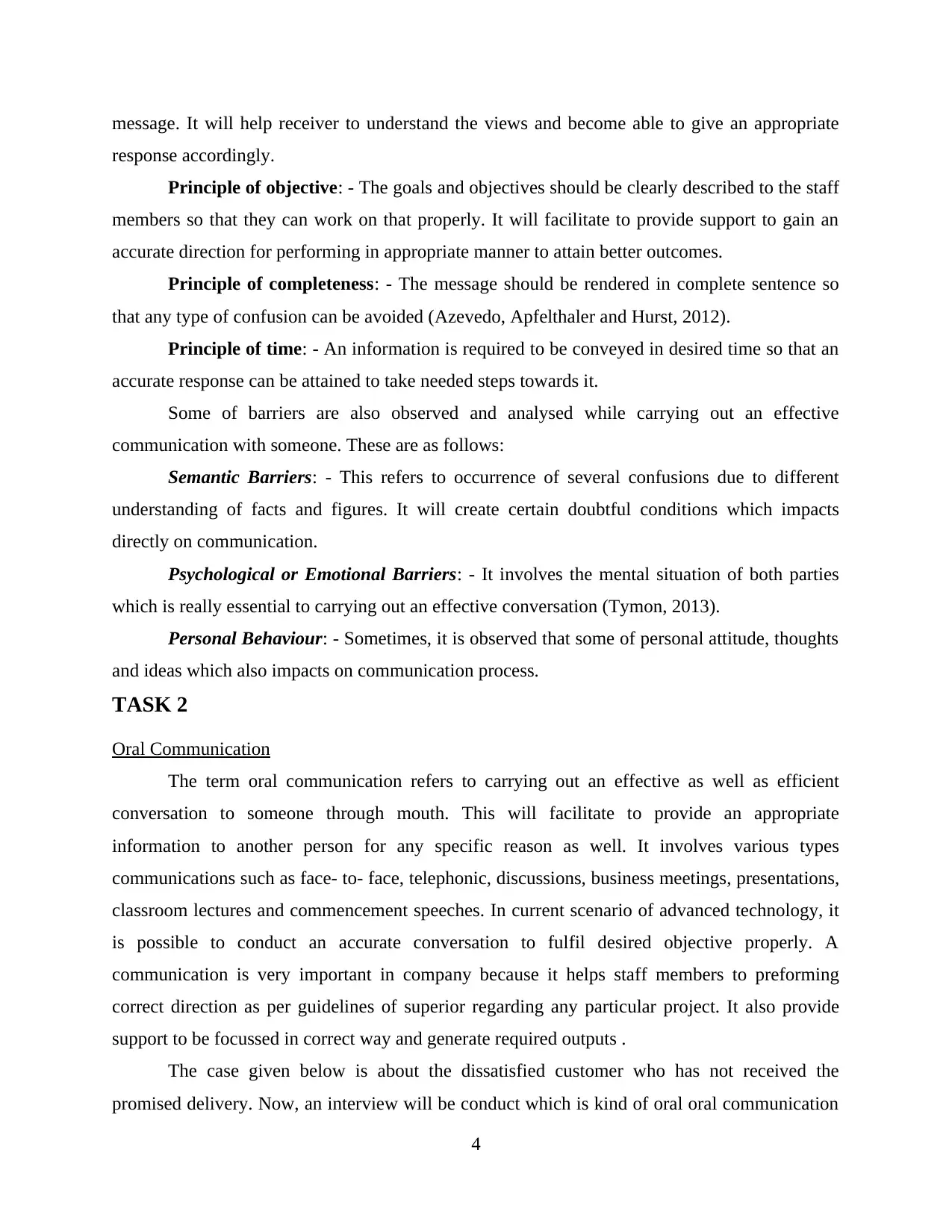
message. It will help receiver to understand the views and become able to give an appropriate
response accordingly.
Principle of objective: - The goals and objectives should be clearly described to the staff
members so that they can work on that properly. It will facilitate to provide support to gain an
accurate direction for performing in appropriate manner to attain better outcomes.
Principle of completeness: - The message should be rendered in complete sentence so
that any type of confusion can be avoided (Azevedo, Apfelthaler and Hurst, 2012).
Principle of time: - An information is required to be conveyed in desired time so that an
accurate response can be attained to take needed steps towards it.
Some of barriers are also observed and analysed while carrying out an effective
communication with someone. These are as follows:
Semantic Barriers: - This refers to occurrence of several confusions due to different
understanding of facts and figures. It will create certain doubtful conditions which impacts
directly on communication.
Psychological or Emotional Barriers: - It involves the mental situation of both parties
which is really essential to carrying out an effective conversation (Tymon, 2013).
Personal Behaviour: - Sometimes, it is observed that some of personal attitude, thoughts
and ideas which also impacts on communication process.
TASK 2
Oral Communication
The term oral communication refers to carrying out an effective as well as efficient
conversation to someone through mouth. This will facilitate to provide an appropriate
information to another person for any specific reason as well. It involves various types
communications such as face- to- face, telephonic, discussions, business meetings, presentations,
classroom lectures and commencement speeches. In current scenario of advanced technology, it
is possible to conduct an accurate conversation to fulfil desired objective properly. A
communication is very important in company because it helps staff members to preforming
correct direction as per guidelines of superior regarding any particular project. It also provide
support to be focussed in correct way and generate required outputs .
The case given below is about the dissatisfied customer who has not received the
promised delivery. Now, an interview will be conduct which is kind of oral oral communication
4
response accordingly.
Principle of objective: - The goals and objectives should be clearly described to the staff
members so that they can work on that properly. It will facilitate to provide support to gain an
accurate direction for performing in appropriate manner to attain better outcomes.
Principle of completeness: - The message should be rendered in complete sentence so
that any type of confusion can be avoided (Azevedo, Apfelthaler and Hurst, 2012).
Principle of time: - An information is required to be conveyed in desired time so that an
accurate response can be attained to take needed steps towards it.
Some of barriers are also observed and analysed while carrying out an effective
communication with someone. These are as follows:
Semantic Barriers: - This refers to occurrence of several confusions due to different
understanding of facts and figures. It will create certain doubtful conditions which impacts
directly on communication.
Psychological or Emotional Barriers: - It involves the mental situation of both parties
which is really essential to carrying out an effective conversation (Tymon, 2013).
Personal Behaviour: - Sometimes, it is observed that some of personal attitude, thoughts
and ideas which also impacts on communication process.
TASK 2
Oral Communication
The term oral communication refers to carrying out an effective as well as efficient
conversation to someone through mouth. This will facilitate to provide an appropriate
information to another person for any specific reason as well. It involves various types
communications such as face- to- face, telephonic, discussions, business meetings, presentations,
classroom lectures and commencement speeches. In current scenario of advanced technology, it
is possible to conduct an accurate conversation to fulfil desired objective properly. A
communication is very important in company because it helps staff members to preforming
correct direction as per guidelines of superior regarding any particular project. It also provide
support to be focussed in correct way and generate required outputs .
The case given below is about the dissatisfied customer who has not received the
promised delivery. Now, an interview will be conduct which is kind of oral oral communication
4
⊘ This is a preview!⊘
Do you want full access?
Subscribe today to unlock all pages.

Trusted by 1+ million students worldwide
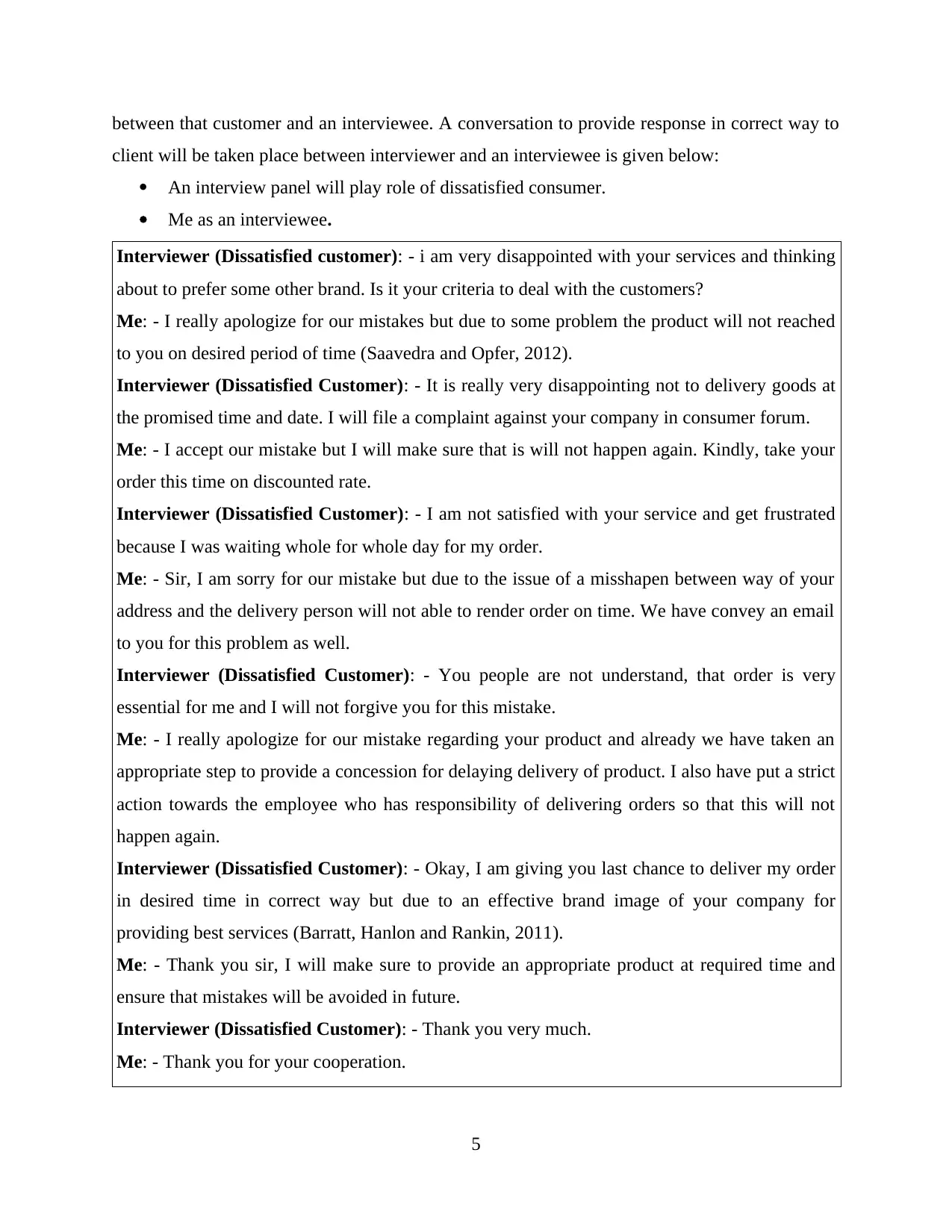
between that customer and an interviewee. A conversation to provide response in correct way to
client will be taken place between interviewer and an interviewee is given below:
An interview panel will play role of dissatisfied consumer.
Me as an interviewee.
Interviewer (Dissatisfied customer): - i am very disappointed with your services and thinking
about to prefer some other brand. Is it your criteria to deal with the customers?
Me: - I really apologize for our mistakes but due to some problem the product will not reached
to you on desired period of time (Saavedra and Opfer, 2012).
Interviewer (Dissatisfied Customer): - It is really very disappointing not to delivery goods at
the promised time and date. I will file a complaint against your company in consumer forum.
Me: - I accept our mistake but I will make sure that is will not happen again. Kindly, take your
order this time on discounted rate.
Interviewer (Dissatisfied Customer): - I am not satisfied with your service and get frustrated
because I was waiting whole for whole day for my order.
Me: - Sir, I am sorry for our mistake but due to the issue of a misshapen between way of your
address and the delivery person will not able to render order on time. We have convey an email
to you for this problem as well.
Interviewer (Dissatisfied Customer): - You people are not understand, that order is very
essential for me and I will not forgive you for this mistake.
Me: - I really apologize for our mistake regarding your product and already we have taken an
appropriate step to provide a concession for delaying delivery of product. I also have put a strict
action towards the employee who has responsibility of delivering orders so that this will not
happen again.
Interviewer (Dissatisfied Customer): - Okay, I am giving you last chance to deliver my order
in desired time in correct way but due to an effective brand image of your company for
providing best services (Barratt, Hanlon and Rankin, 2011).
Me: - Thank you sir, I will make sure to provide an appropriate product at required time and
ensure that mistakes will be avoided in future.
Interviewer (Dissatisfied Customer): - Thank you very much.
Me: - Thank you for your cooperation.
5
client will be taken place between interviewer and an interviewee is given below:
An interview panel will play role of dissatisfied consumer.
Me as an interviewee.
Interviewer (Dissatisfied customer): - i am very disappointed with your services and thinking
about to prefer some other brand. Is it your criteria to deal with the customers?
Me: - I really apologize for our mistakes but due to some problem the product will not reached
to you on desired period of time (Saavedra and Opfer, 2012).
Interviewer (Dissatisfied Customer): - It is really very disappointing not to delivery goods at
the promised time and date. I will file a complaint against your company in consumer forum.
Me: - I accept our mistake but I will make sure that is will not happen again. Kindly, take your
order this time on discounted rate.
Interviewer (Dissatisfied Customer): - I am not satisfied with your service and get frustrated
because I was waiting whole for whole day for my order.
Me: - Sir, I am sorry for our mistake but due to the issue of a misshapen between way of your
address and the delivery person will not able to render order on time. We have convey an email
to you for this problem as well.
Interviewer (Dissatisfied Customer): - You people are not understand, that order is very
essential for me and I will not forgive you for this mistake.
Me: - I really apologize for our mistake regarding your product and already we have taken an
appropriate step to provide a concession for delaying delivery of product. I also have put a strict
action towards the employee who has responsibility of delivering orders so that this will not
happen again.
Interviewer (Dissatisfied Customer): - Okay, I am giving you last chance to deliver my order
in desired time in correct way but due to an effective brand image of your company for
providing best services (Barratt, Hanlon and Rankin, 2011).
Me: - Thank you sir, I will make sure to provide an appropriate product at required time and
ensure that mistakes will be avoided in future.
Interviewer (Dissatisfied Customer): - Thank you very much.
Me: - Thank you for your cooperation.
5
Paraphrase This Document
Need a fresh take? Get an instant paraphrase of this document with our AI Paraphraser
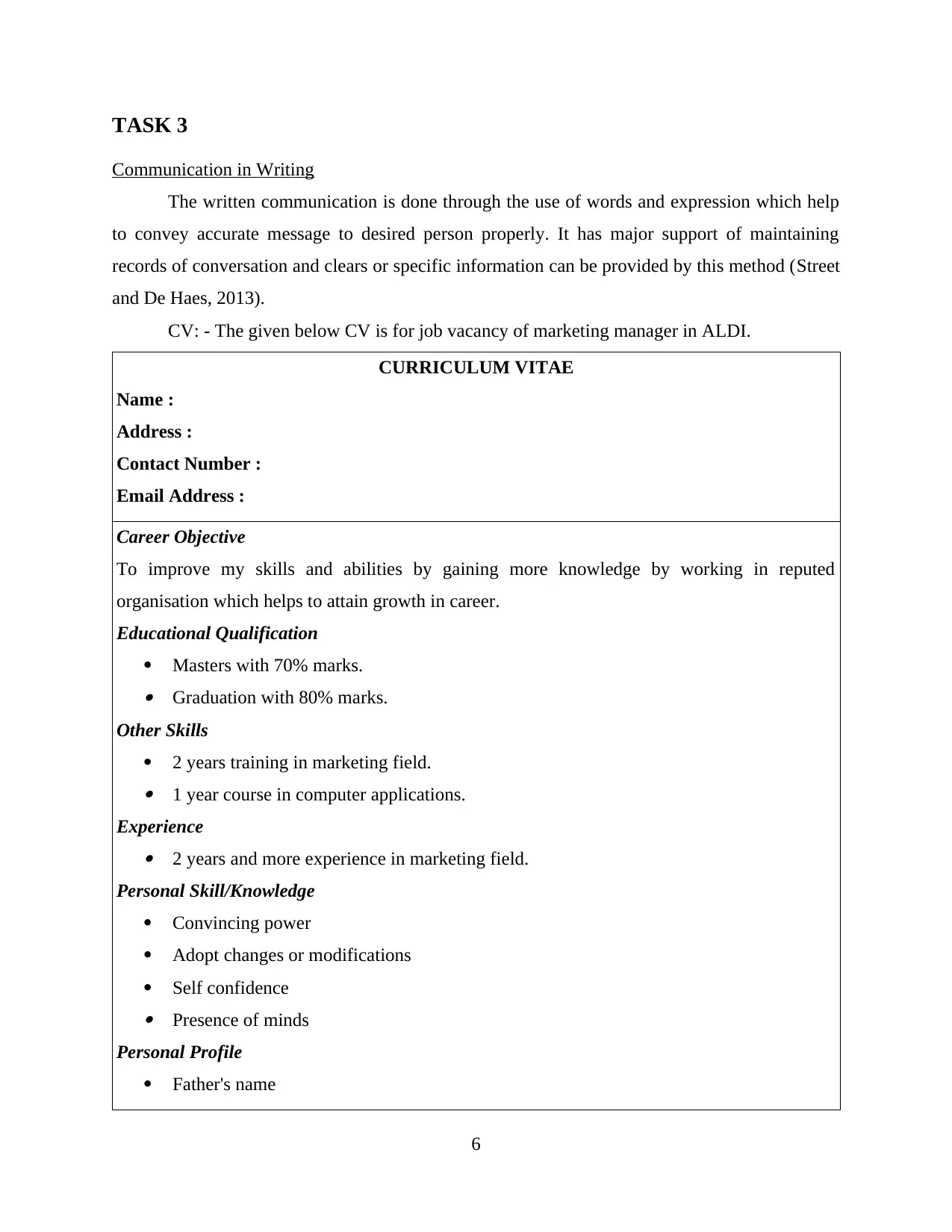
TASK 3
Communication in Writing
The written communication is done through the use of words and expression which help
to convey accurate message to desired person properly. It has major support of maintaining
records of conversation and clears or specific information can be provided by this method (Street
and De Haes, 2013).
CV: - The given below CV is for job vacancy of marketing manager in ALDI.
CURRICULUM VITAE
Name :
Address :
Contact Number :
Email Address :
Career Objective
To improve my skills and abilities by gaining more knowledge by working in reputed
organisation which helps to attain growth in career.
Educational Qualification
Masters with 70% marks. Graduation with 80% marks.
Other Skills
2 years training in marketing field. 1 year course in computer applications.
Experience 2 years and more experience in marketing field.
Personal Skill/Knowledge
Convincing power
Adopt changes or modifications
Self confidence Presence of minds
Personal Profile
Father's name
6
Communication in Writing
The written communication is done through the use of words and expression which help
to convey accurate message to desired person properly. It has major support of maintaining
records of conversation and clears or specific information can be provided by this method (Street
and De Haes, 2013).
CV: - The given below CV is for job vacancy of marketing manager in ALDI.
CURRICULUM VITAE
Name :
Address :
Contact Number :
Email Address :
Career Objective
To improve my skills and abilities by gaining more knowledge by working in reputed
organisation which helps to attain growth in career.
Educational Qualification
Masters with 70% marks. Graduation with 80% marks.
Other Skills
2 years training in marketing field. 1 year course in computer applications.
Experience 2 years and more experience in marketing field.
Personal Skill/Knowledge
Convincing power
Adopt changes or modifications
Self confidence Presence of minds
Personal Profile
Father's name
6
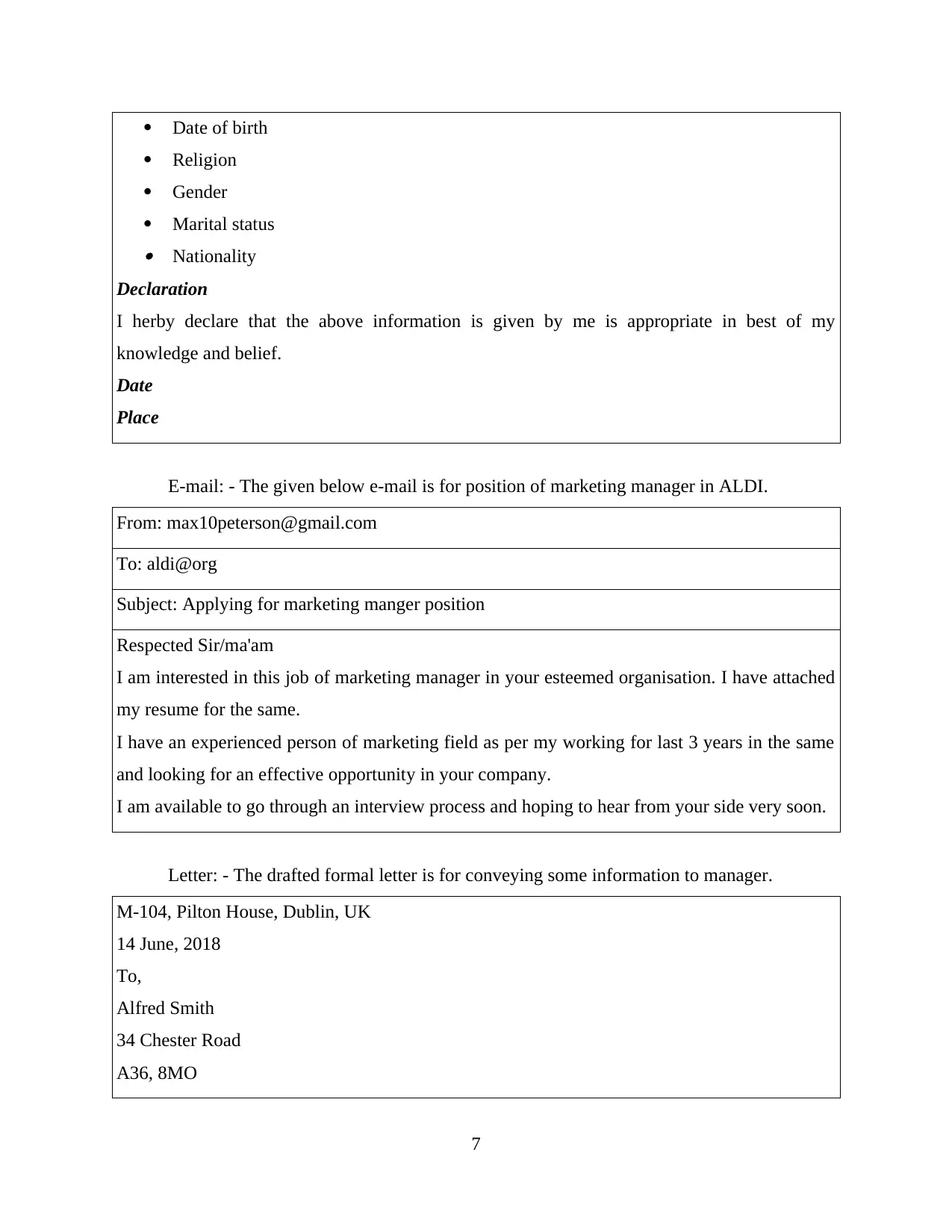
Date of birth
Religion
Gender
Marital status Nationality
Declaration
I herby declare that the above information is given by me is appropriate in best of my
knowledge and belief.
Date
Place
E-mail: - The given below e-mail is for position of marketing manager in ALDI.
From: max10peterson@gmail.com
To: aldi@org
Subject: Applying for marketing manger position
Respected Sir/ma'am
I am interested in this job of marketing manager in your esteemed organisation. I have attached
my resume for the same.
I have an experienced person of marketing field as per my working for last 3 years in the same
and looking for an effective opportunity in your company.
I am available to go through an interview process and hoping to hear from your side very soon.
Letter: - The drafted formal letter is for conveying some information to manager.
M-104, Pilton House, Dublin, UK
14 June, 2018
To,
Alfred Smith
34 Chester Road
A36, 8MO
7
Religion
Gender
Marital status Nationality
Declaration
I herby declare that the above information is given by me is appropriate in best of my
knowledge and belief.
Date
Place
E-mail: - The given below e-mail is for position of marketing manager in ALDI.
From: max10peterson@gmail.com
To: aldi@org
Subject: Applying for marketing manger position
Respected Sir/ma'am
I am interested in this job of marketing manager in your esteemed organisation. I have attached
my resume for the same.
I have an experienced person of marketing field as per my working for last 3 years in the same
and looking for an effective opportunity in your company.
I am available to go through an interview process and hoping to hear from your side very soon.
Letter: - The drafted formal letter is for conveying some information to manager.
M-104, Pilton House, Dublin, UK
14 June, 2018
To,
Alfred Smith
34 Chester Road
A36, 8MO
7
⊘ This is a preview!⊘
Do you want full access?
Subscribe today to unlock all pages.

Trusted by 1+ million students worldwide
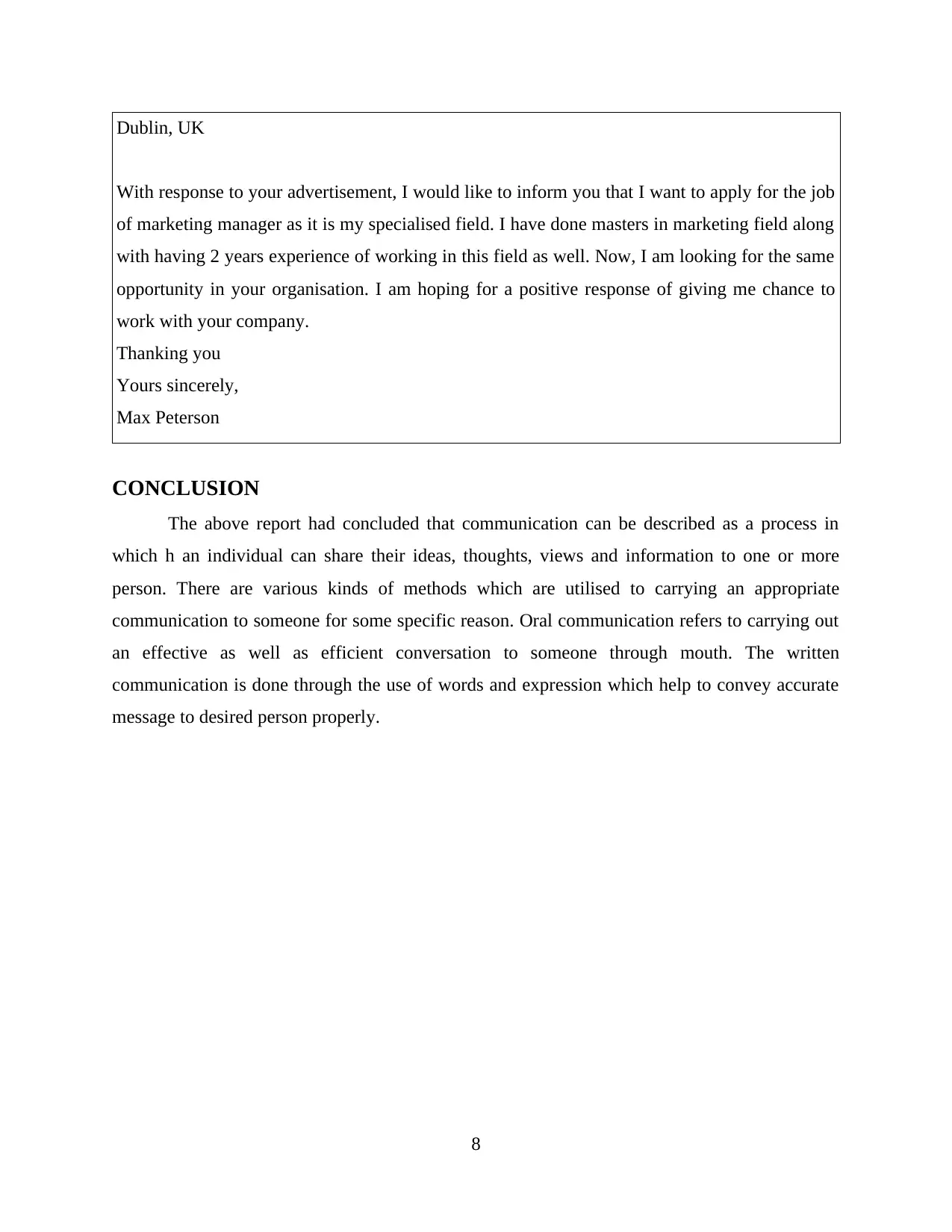
Dublin, UK
With response to your advertisement, I would like to inform you that I want to apply for the job
of marketing manager as it is my specialised field. I have done masters in marketing field along
with having 2 years experience of working in this field as well. Now, I am looking for the same
opportunity in your organisation. I am hoping for a positive response of giving me chance to
work with your company.
Thanking you
Yours sincerely,
Max Peterson
CONCLUSION
The above report had concluded that communication can be described as a process in
which h an individual can share their ideas, thoughts, views and information to one or more
person. There are various kinds of methods which are utilised to carrying an appropriate
communication to someone for some specific reason. Oral communication refers to carrying out
an effective as well as efficient conversation to someone through mouth. The written
communication is done through the use of words and expression which help to convey accurate
message to desired person properly.
8
With response to your advertisement, I would like to inform you that I want to apply for the job
of marketing manager as it is my specialised field. I have done masters in marketing field along
with having 2 years experience of working in this field as well. Now, I am looking for the same
opportunity in your organisation. I am hoping for a positive response of giving me chance to
work with your company.
Thanking you
Yours sincerely,
Max Peterson
CONCLUSION
The above report had concluded that communication can be described as a process in
which h an individual can share their ideas, thoughts, views and information to one or more
person. There are various kinds of methods which are utilised to carrying an appropriate
communication to someone for some specific reason. Oral communication refers to carrying out
an effective as well as efficient conversation to someone through mouth. The written
communication is done through the use of words and expression which help to convey accurate
message to desired person properly.
8
Paraphrase This Document
Need a fresh take? Get an instant paraphrase of this document with our AI Paraphraser
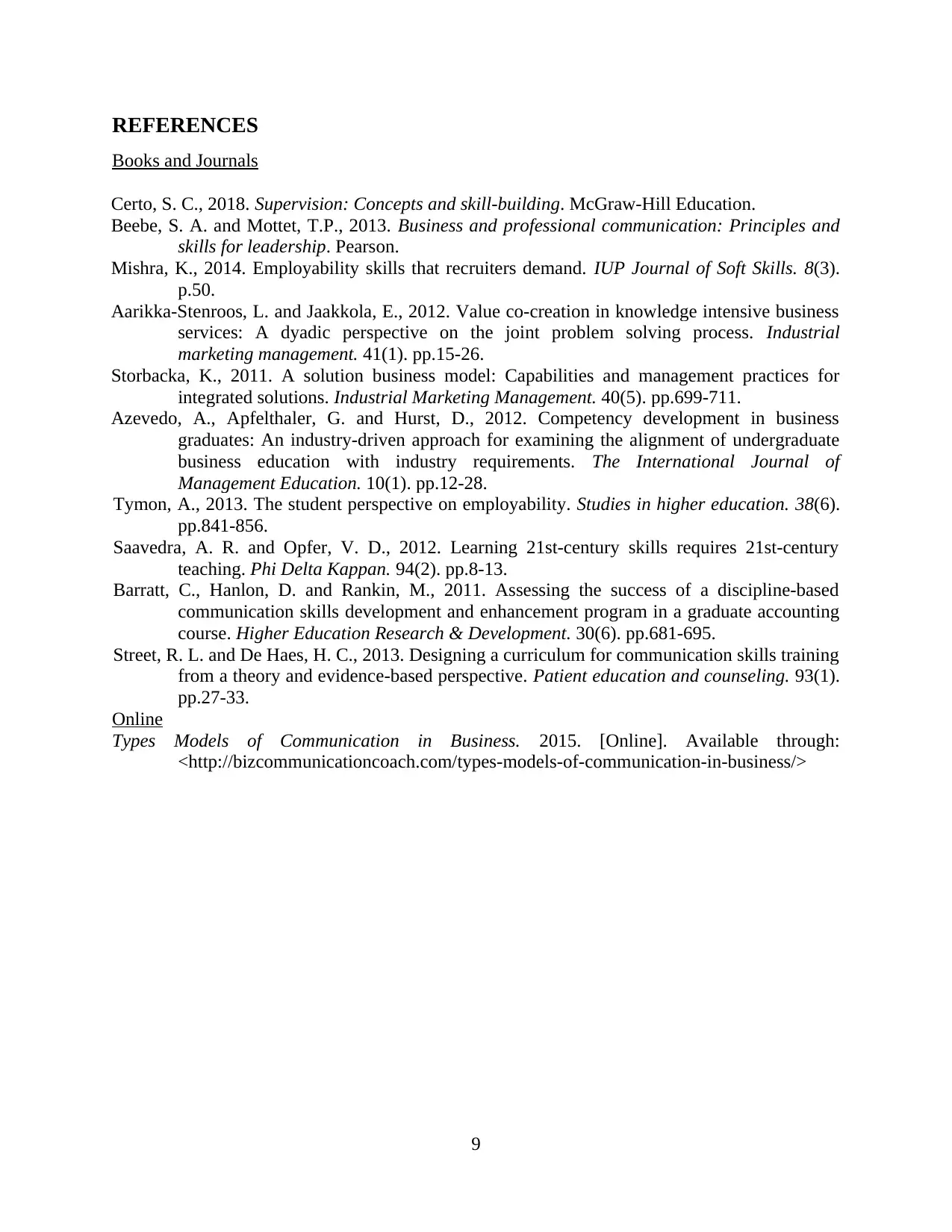
REFERENCES
Books and Journals
Certo, S. C., 2018. Supervision: Concepts and skill-building. McGraw-Hill Education.
Beebe, S. A. and Mottet, T.P., 2013. Business and professional communication: Principles and
skills for leadership. Pearson.
Mishra, K., 2014. Employability skills that recruiters demand. IUP Journal of Soft Skills. 8(3).
p.50.
Aarikka-Stenroos, L. and Jaakkola, E., 2012. Value co-creation in knowledge intensive business
services: A dyadic perspective on the joint problem solving process. Industrial
marketing management. 41(1). pp.15-26.
Storbacka, K., 2011. A solution business model: Capabilities and management practices for
integrated solutions. Industrial Marketing Management. 40(5). pp.699-711.
Azevedo, A., Apfelthaler, G. and Hurst, D., 2012. Competency development in business
graduates: An industry-driven approach for examining the alignment of undergraduate
business education with industry requirements. The International Journal of
Management Education. 10(1). pp.12-28.
Tymon, A., 2013. The student perspective on employability. Studies in higher education. 38(6).
pp.841-856.
Saavedra, A. R. and Opfer, V. D., 2012. Learning 21st-century skills requires 21st-century
teaching. Phi Delta Kappan. 94(2). pp.8-13.
Barratt, C., Hanlon, D. and Rankin, M., 2011. Assessing the success of a discipline-based
communication skills development and enhancement program in a graduate accounting
course. Higher Education Research & Development. 30(6). pp.681-695.
Street, R. L. and De Haes, H. C., 2013. Designing a curriculum for communication skills training
from a theory and evidence-based perspective. Patient education and counseling. 93(1).
pp.27-33.
Online
Types Models of Communication in Business. 2015. [Online]. Available through:
<http://bizcommunicationcoach.com/types-models-of-communication-in-business/>
9
Books and Journals
Certo, S. C., 2018. Supervision: Concepts and skill-building. McGraw-Hill Education.
Beebe, S. A. and Mottet, T.P., 2013. Business and professional communication: Principles and
skills for leadership. Pearson.
Mishra, K., 2014. Employability skills that recruiters demand. IUP Journal of Soft Skills. 8(3).
p.50.
Aarikka-Stenroos, L. and Jaakkola, E., 2012. Value co-creation in knowledge intensive business
services: A dyadic perspective on the joint problem solving process. Industrial
marketing management. 41(1). pp.15-26.
Storbacka, K., 2011. A solution business model: Capabilities and management practices for
integrated solutions. Industrial Marketing Management. 40(5). pp.699-711.
Azevedo, A., Apfelthaler, G. and Hurst, D., 2012. Competency development in business
graduates: An industry-driven approach for examining the alignment of undergraduate
business education with industry requirements. The International Journal of
Management Education. 10(1). pp.12-28.
Tymon, A., 2013. The student perspective on employability. Studies in higher education. 38(6).
pp.841-856.
Saavedra, A. R. and Opfer, V. D., 2012. Learning 21st-century skills requires 21st-century
teaching. Phi Delta Kappan. 94(2). pp.8-13.
Barratt, C., Hanlon, D. and Rankin, M., 2011. Assessing the success of a discipline-based
communication skills development and enhancement program in a graduate accounting
course. Higher Education Research & Development. 30(6). pp.681-695.
Street, R. L. and De Haes, H. C., 2013. Designing a curriculum for communication skills training
from a theory and evidence-based perspective. Patient education and counseling. 93(1).
pp.27-33.
Online
Types Models of Communication in Business. 2015. [Online]. Available through:
<http://bizcommunicationcoach.com/types-models-of-communication-in-business/>
9
1 out of 11
Related Documents
Your All-in-One AI-Powered Toolkit for Academic Success.
+13062052269
info@desklib.com
Available 24*7 on WhatsApp / Email
![[object Object]](/_next/static/media/star-bottom.7253800d.svg)
Unlock your academic potential
Copyright © 2020–2025 A2Z Services. All Rights Reserved. Developed and managed by ZUCOL.





